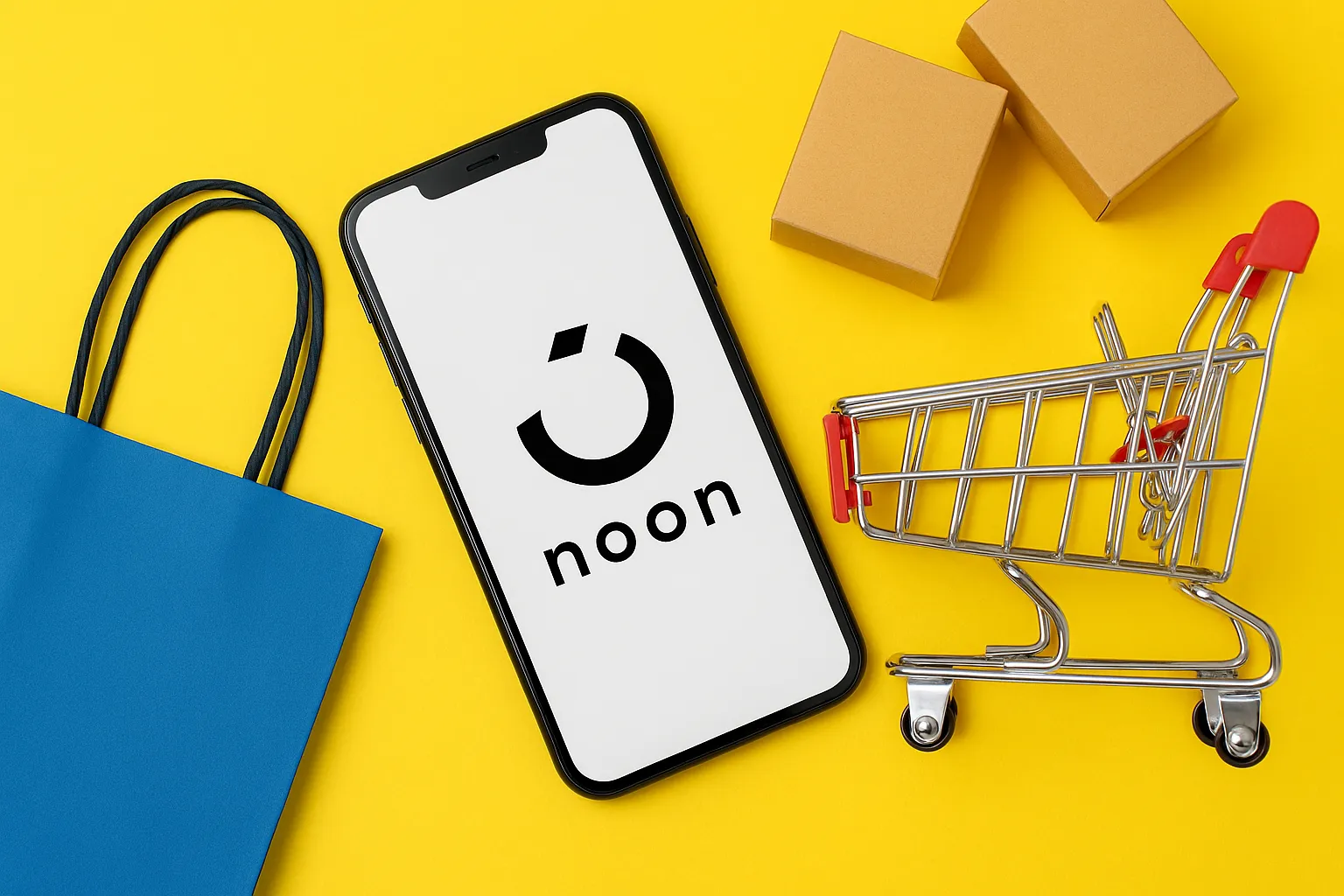Business Model of Noon has rapidly become the leading e-commerce marketplace in the Middle East, offering everything from electronics and groceries to fashion and home goods. Launched in 2017, Noon competes head-to-head with global giants like Amazon while adapting to regional preferences.
Studying Noon’s business model of Noon crucial for any founder interested in building an online marketplace that blends retail, logistics, and fintech. Its strategy showcases how localized innovation can drive impressive market share and sustainable revenue.
What is Noon & How It Works
What Problem Does Noon Solve?
Noon addresses two major gaps in the Middle East:
- Limited access to diverse online retail options.
- Slow, fragmented delivery services across cities and countries.
By creating a unified marketplace with integrated logistics, Noon makes shopping faster, more reliable, and more affordable.
Who Uses Noon?
Noon caters to:
- Everyday consumers buying essentials, gadgets, and luxury products.
- Small and medium-sized merchants seeking a digital storefront.
- Large brands leveraging Noon’s logistics to reach regional customers.
How Does Noon workOperate?
The platform functions as both a retailer and a marketplace:
- Retail Model: Noon buys products wholesale and sells them directly.
- Marketplace Model: Third-party sellers list their products and fulfill orders.
- Fulfilled by Noon: Sellers store inventory in Noon warehouses, and Noon manages packing and delivery.
- Noon Pay: A digital wallet for seamless transactions.
- Quick Delivery: Same-day and next-day shipping options in key markets.
This blended approach allows Noon to control quality, speed, and customer experience while scaling its catalog and seller base.
Read More : What is Noon App and How Does It Work?
Target Users of Noon Platform
Noon’s business model is designed to serve a diverse range of customer segments across the Middle East. Here’s a closer look at who uses the platform:
1. Value-Seeking Shoppers
Consumers looking for deals, flash sales, and affordable pricing across categories like electronics, fashion, and groceries. They are highly responsive to promotions and seasonal discounts that maximize value for money.
2. Convenience-Focused Buyers
Busy professionals and families who rely on same-day or next-day delivery for household essentials. They choose Noon for speed, reliability, and the ease of ordering everything in one place.
3. Tech-Savvy Millennials
Younger customers comfortable with digital wallets (Noon Pay) and in-app shopping experiences. They prefer seamless transactions, app-exclusive deals, and personalized recommendations.
4. Small & Medium Businesses
Merchants who want to expand online without investing in their own logistics or payment infrastructure. They use Noon’s marketplace and fulfillment services to grow their customer base quickly.
5. Brand-Conscious Shoppers
Customers purchasing premium and branded products, attracted by Noon’s authenticity guarantees. They value verified sellers, genuine products, and premium delivery options.
6. Cross-Border Buyers
Shoppers in countries like Saudi Arabia, UAE, and Egypt who value regional availability and fast shipping. They trust Noon to deliver quality products across borders with minimal delays.
Understanding this audience mix is key to appreciating how Noon balances scale with personalization.
Features that Support the Business Model
Noon’s growth and profitability rely on several powerful features that drive revenue and customer loyalty. Here are the core components:
1. Marketplace Listings
Thousands of third-party sellers list products, paying commissions and fees to access Noon’s customer base.
2. Fulfilled by Noon (FBN)
Merchants can store inventory in Noon’s warehouses. Noon handles picking, packing, and delivery—creating an additional revenue stream through fulfillment fees.
3. Noon Express
Fast shipping services (same-day or next-day) incentivize customers to choose Noon over competitors and increase order frequency.
4. Noon Pay
A built-in digital wallet that simplifies payments, promotes cashless transactions, and can offer cashback rewards.
5. Sponsored Products & Ads
Sellers can pay for sponsored placements, boosting visibility in search results and category pages.
6. Customer Loyalty Programs
Regular promotions, discount vouchers, and exclusive sales encourage repeat purchases.
7. Cross-Border Logistics Network
An advanced logistics infrastructure that supports delivery across multiple countries, driving higher order volumes.
These features combine to create a scalable ecosystem that benefits both consumers and sellers while generating diverse revenue streams.
Read More : Best Noon Clone Scripts in 2025: Features & Pricing Compared
Revenue Streams of Noon
Noon has built a multi-layered revenue model that blends retail sales, marketplace fees, and financial services. Here’s a clear breakdown:
| Revenue Stream | How It Works |
| Product Sales | Revenue from selling goods directly to consumers. |
| Marketplace Commission | Fees charged to third-party sellers per transaction. |
| Fulfillment Fees | Charges for storing, packing, and delivering seller products. |
| Advertising & Sponsored Listings | Revenue from sellers who pay to promote products. |
| Noon Pay Transaction Fees | Small fees earned from processing payments via Noon Pay. |
| Logistics Services | Fees from delivery and cross-border shipping services. |
Highlights:
- Product Sales: Largest revenue driver, especially during sales events and seasonal promotions.
- Marketplace Commission: A percentage (often 5–20%) of each third-party sale.
- Fulfillment Fees: Merchants pay storage and handling fees for using Noon’s warehouses.
- Advertising: Sellers invest in sponsored placements to drive visibility.
- Noon Pay: Transaction fees plus opportunities for financial product cross-selling.
- Logistics Services: Monetized delivery solutions for sellers outside Noon’s main marketplace.
This diversified model helps Noon maintain strong cash flow and scale across categories
Read more : Understanding the Revenue Model of Noon and Its Growth Engine
Cost Structure to Operate Noon
Running a large-scale e-commerce platform like Noon involves significant operational and strategic expenses. Here are the main cost drivers:
1. Inventory Procurement
Purchasing products wholesale for direct retail sales is a major capital requirement.
2. Warehousing & Fulfillment
Operating large distribution centers across multiple countries, including storage, staff, and facility maintenance.
3. Logistics & Last-Mile Delivery
Fleet management, fuel, packaging, and partnerships with courier services to ensure fast shipping.
4. Technology Infrastructure
Development and maintenance of the app, website, payment systems, and internal tools.
5. Marketing & Customer Acquisition
Spending on digital advertising, influencer collaborations, and loyalty programs to drive traffic and conversions.
6. Seller Support & Operations
Onboarding new merchants, managing disputes, and providing customer service.
7. Payment Processing Fees
Fees associated with handling transactions, especially when offering digital wallets and cashback rewards.
This robust cost structure is why scaling logistics and technology efficiently is crucial to profitability in marketplaces like Noon.
Read more : The Marketing Strategy Behind Noon (And How to Clone Its Success)
2024–2025 Innovations or Updates
Noon has been evolving quickly to stay ahead of competitors and meet rising customer expectations. Here are some notable updates and innovations shaping its business model in 2024–2025:
1. Expansion of Quick Commerce
Noon has invested heavily in Noon Minutes, an ultra-fast delivery service promising grocery and essentials delivery within 15–30 minutes in major cities.
2. Enhanced Noon Pay Features
New capabilities like installment payments, digital gift cards, and loyalty-linked cashback have made Noon Pay more competitive as a fintech solution.
3. Cross-Border Marketplace Growth
Efforts to streamline cross-border selling are underway, including warehousing hubs in Saudi Arabia and Egypt to reduce delivery times.
4. Sustainable Packaging Initiatives
Sustainability has become a focus, with biodegradable packaging and eco-friendly delivery practices rolled out across the UAE and KSA.
5. AI-Powered Personalization
Upgrades to the recommendation engine are helping improve conversion rates by serving smarter product suggestions and dynamic pricing.
6. Seller Education Programs
Noon has launched new training resources for merchants, making it easier for small businesses to list and grow on the platform.
These updates show how Noon balances fast logistics, fintech innovation, and regional customization to protect its market share and boost profitability.
Takeaways for Startup Founders
If you’re planning to build an e-commerce marketplace, Noon’s model offers powerful lessons on scaling, monetization, and customer loyalty. Here are key insights to consider:
1. Own Your Logistics
Fast, reliable delivery is a massive differentiator. Investing in warehousing and last-mile fulfillment can boost retention and trust.
2. Blend Retail and Marketplace Models
Combining direct sales with third-party sellers helps balance cash flow and inventory risk.
3. Build Fintech into Your Platform
A proprietary payment solution (like Noon Pay) not only drives loyalty but also unlocks new revenue streams from transaction fees.
4. Focus on Regional Needs
Localization—whether in language, payment methods, or delivery preferences—can help you outmaneuver global players.
5. Diversify Revenue Early
Advertising, fulfillment services, and cross-border logistics all help create a resilient business model.
Read more : Why Startups Choose Our Noon Clone Over Custom Development
Why Build with Miracuves?
At Miracuves, we specialize in ready-made marketplace solutions inspired by proven platforms like Noon. Our e-commerce clones come pre-equipped with:
- Advanced seller dashboards
- Integrated payment wallets
- Robust fulfillment modules
- Multi-country support
- Custom branding options
With Miracuves, you save months of development time and can launch your platform with confidence and speed.
If you’re serious about building an e-commerce marketplace that can scale across regions, our eCommerce app solutions and marketplace clones are designed for founders like you.
Conclusion :
Noon has proven that with the right mix of logistics, technology, and regional focus, an e-commerce platform can thrive even in competitive markets. Its business model—combining direct retail, a marketplace ecosystem, digital payments, and fast delivery—offers a blueprint for founders who want to build sustainable marketplaces.
If you’re planning to launch an app inspired by Noon, partnering with Miracuves gives you a serious advantage. We provide customizable, ready-made marketplace solutions that help you:
- Launch faster without starting from scratch
- Keep costs predictable
- Scale features and geographies as you grow
Ready to create your own e-commerce success story?
Contact Miracuves today to discuss how we can help you build a powerful marketplace platform that stands out.
FAQs
1. How does Noon make money?
Noon earns revenue through multiple streams: direct product sales, commissions on marketplace transactions, fulfillment fees for storing and delivering products, advertising fees for sponsored listings, and transaction fees from Noon Pay. This diversified approach ensures steady cash flow.
2. What makes Noon different from Amazon?
While Amazon is a global marketplace, Noon is deeply localized. It tailors payment options, delivery networks, and customer support to Middle Eastern markets. Noon also invests heavily in regional warehousing and quick-commerce infrastructure.
3. How much does it cost to build a marketplace like Noon?
Costs vary depending on features, logistics, and scale. However, by using a pre-built solution from Miracuves, you can significantly reduce development time and budget compared to building from scratch.
4. Can I integrate a digital wallet like Noon Pay into my marketplace?
Absolutely. Digital wallets are a proven way to boost conversions and loyalty. Miracuves’ e-commerce solutions include integrated payment modules, making it easy to offer a secure and branded wallet.
5. How quickly can I launch an app similar to Noon?
With Miracuves’ ready-made marketplace platforms, you can launch in weeks rather than months. We handle the heavy lifting—customization, deployment, and scaling—so you can focus on growing your business.
Related Articles :
- Revenue Model of Flipkart: How India’s E-commerce Titan Makes Money
- Business Model of Etsy | How the Handmade Marketplace Generates Billions
- Business Model of Amazon in 2025: How the E-Commerce Giant Earns, Scales, and Stays Ahead
- How to Develop an E-commerce and Online Shopping Platform App
- How to Build an App Like Amazon: Full Developer Guide








